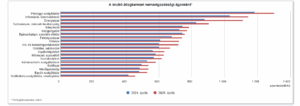
The Oeconomus Center’s analysis reflects current economic factors influencing the prices of seasonal foods like ice-cream in Hungary. Continue reading

In April this year, the average gross income of full-time employees was 708,300 forints (approx. 1,755 euros), 9.8 percent higher than a year earlier, according to a flash report released by the Central Statistical Office (KSH). The data also shows that the average net wage was 486,500 forints (approx. 1,205 euros), 9.6 percent higher than in the same month in 2024, Világgazdaság reported.
Based on data from the Hungarian Central Statistical Office (KSH), the average gross wage was 9.8 percent higher than a year earlier, the average net wage was 9.6 percent higher, and real wages were 5.2 percent higher. The median gross earnings were 564,800 forints (approx. 1,399 euros) and the median net earnings were 392,700 forints (approx. 973 euros), both exceeding the same period of the previous year by 10.2 percent.

Gross Earnings and Annual Growth Rates by Income Bracket for Full-Time Employment, January–April 2025. Photo: Hungarian Central Statistical Office
The regular gross average earnings, excluding bonuses, rewards, and one-month special allowances, were estimated at 657,800 forints (approx. 1,629 euros), which is 10.3 percent more than in the same period last year.
The regular gross average earnings were 654,600 forints (approx. 1,621 euros) in enterprises, 656,000 forints (approx. 1,624 euros) in the budget sector and 692,900 forints (approx. 1,716 euros) in the non-profit sector, increasing by 10.7%, 8.4%, and 11.8% respectively over the year. Real earnings rose by 5.2 percent compared to the same period last year, with consumer prices rising by 4.2 percent.

Gross Average Earnings as a Share of the National Economy by Sector. Photo: Hungarian Central Statistical Office